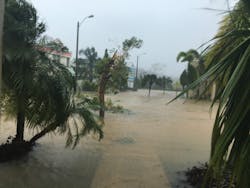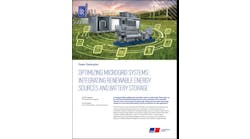Puerto Rico’s utility needs to act on solar, storage and microgrids, says industry group
A solar and storage advocacy group in Puerto Rico wants the island’s utility to get moving on required investments in solar, storage and microgrids as ordered by regulators.
The Solar and Energy Storage Association of Puerto Rico (SESA) said the Puerto Rico Electric Power Authority (PREPA) needs to push forward to meet the island’s aggressive renewable portfolio standard — 40% renewables by 2025 and 100% by 2050. This will mean acquiring about 3,750 MW of renewables by the 2025 deadline, according to Javier Rua-Jovet, chief policy officer for SESA.
In a Dec. 28, 2021, order, the Puerto Rico Energy Bureau (PREB) required PREPA to submit by January 10 an additional four projects of solar PV and an additional six storage bids, which is more than the storage and PV PREPA has said it has acquired.
At this time, PREPA had not met the January 10 deadline, said Rua-Jovet.
“PREB basically said, ‘We told you what we wanted, we want 1,000 MW of solar and 500 MW of storage for round one [the first phase of the request for proposals] and you’re going to do that,” Rua-Jovet said. The utility must have a contracted project built within 24 months of signing a power purchase agreement, he added.
Marching orders
In the December 28 order, the energy bureau noted that the utility had proposed contract awards for 220 MW of battery energy storage resources, based on a price of $120/MWh or less. “The Energy Bureau orders PREPA to directly include and file with the Energy Bureau at least the next additional six battery energy storage proposed offerings representing 445 MW additional to PREPA’s identified three project offerings in its continuing … evaluation process for battery energy storage resources,” said the order.
In the order, the energy bureau also noted that the utility had proposed awards for 732.72 MW of solar PV, based on its goal of acquiring PV at less than $105/MWh. “The Energy Bureau orders PREPA to include and file with the Energy Bureau at least the next four solar PV proposed offerings representing 130 MW additional nameplate capacity to PREPA’s identified fifteen projects as at this time being in alignment with the IRP [Integrated Resource Plan] action plan for deployment of renewable energy …” said the order.
The efforts aim to help the island meet its aggressive renewable portfolio standard and help the island recover from its entire grid failure that stemmed from Hurricane Maria’s devastation in 2017. Solar and microgrids have become an important part of reconstruction. But much of the development has been piecemeal.
The energy bureau’s directives stem from an August 2020 order calling for microgrids and renewables to be central parts of grid planning in the utility’s integrated resource plan. More recently, under the integrated resource plan docket, the energy regulator required the utility to acquire 1,000 MW of solar and 500 MW of storage.
The move toward solar is expected to take part in a number of stages that reflect Puerto Rico’s Act 17, the Puerto Rico Energy Public Policy Act, which established the renewable portfolio standard.
“The energy bureau is a good actor here, always pushing and pushing and pushing. PREPA sometimes pushes back, that’s in their DNA. We still have 97% fossil fuels, we are addicted to fossil fuels. This is a big cultural change; there’s a push back,” said Rua-Jovet.
Rise of home microgrids
Meanwhile, homeowners are installing about 1,500 solar-plus-storage systems per month, said Rua-Jovet. These qualify as microgrids because they can separate from the main grid. Luma Energy, which operates Puerto Rico’s transmission and distribution system, has said that the number of installations has increased from about 1,100 distributed generation systems per month during the May through July 2021 quarter to more than 1,500 per month during the August to October 2021 quarter. In addition, Luma said it has worked through nearly half of the 8,000-customer backlog on net metering — giving the customers access to net metering — and expects to have worked through it all by the beginning of 2022, Rua-Jovet said.
PREPA is a public corporation of the government of Puerto Rico and owns and operates electric generation, transmission and distribution facilities serving all of Puerto Rico. In June 2020, PREPA and the Puerto Rico Public-Private Partnership Authority selected Luma Energy to operate and modernize PREPA’s transmission and distribution system for 15 years through a public-private partnership.
Lack of VPPs
Virtual power plants (VPPs) that take advantage of the home microgrids could be established with the help of private companies, said Rua-Jovet. Aggregators like Sunnova and Sunrun could control the island’s distributed network of home microgrids as a VPP that provides clean power to the grid, he said. But a lack of incentives stands in the way.
“Today, neither aggregator companies nor individual customers are given any financial incentive to help support the grid, leaving this opportunity unfulfilled,” he said.
The island regulator has mandated PREPA procure and activate at least 150 MW of virtual power plant resources through the current competitive bidding process, said Rua-Jovet.
“VPPs are no-brainers since they are existing, already deployed and organically growing resources,” said Rua-Jovet. PREPA has said it will tell regulators how the utility plans to respond to VPP bids by January 30.
PREB ordered the utility to share the VPP bidder information by January 10, and nothing has yet appeared in the docket, he said. Competitive bidding can help move virtual power plants forward, but so could incentives for individual prosumers or aggregators to participate in demand response, brownout prevention, voltage stabilization or other grid service programs, said Rua-Jovet.
“Any compensation also saves all consumers money; whatever the utility would have paid to run the dirtiest, most expensive fuel-oil ‘peaker’ plants is avoided and supplanted by a lesser payment to the aggregators and/or the prosumers,” he said.
Funding available
The lag in action is not because of a lack of funding, Rua-Jovet said.
The federal government appropriated $20 billion in community development block grant funding for Puerto Rico under the Bipartisan Budget Act of 2018 after Hurricane Maria devastated the island and its electricity system. The grants are intended to pay for disaster relief, long-term recovery, restoration of infrastructure and housing and mitigation.
The funds began flowing when President Biden took office, after delays from the Trump administration. The $20 billion includes $1.9 billion for “enhanced or improved electrical power systems” for Puerto Rico.
“All these congressionally approved monies must be deployed as intended, so that Puerto Rican families and businesses are spared from having to relive over and again the nightmare that was Hurricane Maria,” SESA said in comments filed with HUD. “The 2022 hurricane season will be here in a blink of an eye, and congressionally appropriated monies for energy resiliency have not yet flowed in any significant way.”
The funds should be used to deploy solar and storage systems to provide power directly to homes, businesses and critical facilities so they can use them during ongoing brownouts and blackouts, SESA said in its comments. Large-scale solar and storage facilities should also be deployed, SESA said.
The funding also includes $300 million for small solar and storage systems for 3,750 homes that are now starting to be reconstructed after being hit hard by Hurricane Maria, said Rua-Jovet.
Up to $500 million in solar incentives is also part of the funding, but there is no action yet. A grant administrator and program guidelines have not yet been established, said Rua-Jovet.
Smart spending paramount
Puerto Rico has to plan well to use the federal grants, Rua-Jovet said.
“There’s federal money out there. But money spent incorrectly on incentives can freeze the market. We want to make sure monies are true and start flowing in smart ways,” he said.
Slowly but surely, the federal money is starting to make its way to Puerto Rico.
“Under Trump, there was a lot of foot dragging, but now things are happening,” he said.
Track news about solar, storage and microgrids in Puerto Rico. Subscribe to the free Microgrid Knowledge Newsletter.








